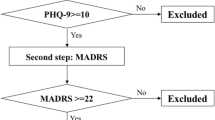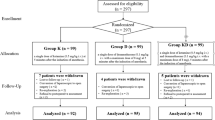Abstract
Background
Anesthesia depth has been associated with mortality. The association between anesthesia depth and presurgery physical and health status, however, is currently debated. Depression is one comorbid condition that warrants investigation given its association to reduced frontal lobe activity and high prevalence in known surgery samples (e.g., gynecologic mass removal).
Purpose
This pilot study examined the hypothesis that severity of acute depressive symptoms would associate with greater sensitivity to anesthesia as measured by a frontal lobe electroencephalogram (EEG)-based monitor during the anesthesia induction phase among women undergoing gynecologic mass removal.
Method
This was a prospective and surgery anesthesia-controlled pilot investigation with 31 women undergoing surgery for removal of pelvic/gynecologic masses. Participants completed the Millon Behavioral Medicine Diagnostic (MBMD) inventory to assess depressive-related symptomatology. A Bispectral Index Score (BIS™) monitor (Aspect Medical Systems Inc., MA) was placed on the left frontal region to measure change in response from a set pre-anesthesia baseline point throughout the induction phase (6.5 min of the anesthetic). BIS™ change was calculated using a modified “area under the curve with respect to ground” formula.
Results
Greater sensitivity to anesthesia during induction was significantly associated with higher MBMD future pessimism scores and marginally associated with higher MBMD depression scores. Depressive personality, anxiety severity, tumor type, age, medication use, and comorbidity scores were not found to be predictors of BIS score change.
Conclusion
These pilot findings suggest that preoperative psychological health and anesthesia response are not independent. Acute presurgery depression and anesthesia response warrant closer empirical examination.



Similar content being viewed by others
References
Bruhn J, Myles PS, Sneyd R, Struys MM. Depth of anaesthesia monitoring: what’s available, what’s validated and what’s next? Br J Anaesth. 2006;97(1):85–94.
Monk TG, Saini V, Weldon BC, Sigl JC. Anesthetic management and one-year mortality after noncardiac surgery. Anesth Analg. 2005;100(1):4–10.
Lindholm ML, Traff S, Granath F, Greenwald SD, Ekbom A, Lennmarken C, et al. Mortality within 2 years after surgery in relation to low intraoperative bispectral index values and preexisting malignant disease. Anesth Analg. 2009;108(2):508–12.
Kertai MD, Pal N, Palanca BJ, Lin N, Searleman SA, Zhang L, et al. Association of perioperative risk factors and cumulative duration of low bispectral index with intermediate-term mortality after cardiac surgery in the B-Unaware Trial. Anesthesiology. 2010;112(5):1116–27.
Muravchick S. The aging process: anesthetic implications. Acta Anaesthesiol Belg. 1998;49(2):85–90.
Drevets WC. Neuroimaging and neuropathological studies of depression: implications for the cognitive-emotional features of mood disorders. Curr Opin Neurobiol. 2001;11(2):240–9.
Cornwell BR, Salvadore G, Colon-Rosario V, Latov DR, Holroyd T, Carver FW, et al. Abnormal hippocampal functioning and impaired spatial navigation in depressed individuals: evidence from whole-head magnetoencephalography. Am J Psychiatry. 2010;167(7):836–44.
Baxter Jr LR, Schwartz JM, Phelps ME, Mazziotta JC, Guze BH, Selin CE, et al. Reduction of prefrontal cortex glucose metabolism common to three types of depression. Arch Gen Psychiatry. 1989;46(3):243–50.
Bonne O, Krausz Y, Shapira B, Bocher M, Karger H, Gorfine M, et al. Increased cerebral blood flow in depressed patients responding to electroconvulsive therapy. J Nucl Med Off Publ Soc Nucl Med. 1996;37(7):1075–80.
Drevets WC. Functional neuroimaging studies of depression: the anatomy of melancholia. Annu Rev Med. 1998;49:341–61.
Hama S, Yamashita H, Shigenobu M, Watanabe A, Kurisu K, Yamawaki S, et al. Post-stroke affective or apathetic depression and lesion location: left frontal lobe and bilateral basal ganglia. Eur Arch Psychiatry Clin Neurosci. 2007;257(3):149–52.
Henriques JB, Davidson RJ. Left frontal hypoactivation in depression. J Abnorm Psychol. 1991;100(4):535–45.
Spalletta G, Guida G, De Angelis D, Caltagirone C. Predictors of cognitive level and depression severity are different in patients with left and right hemispheric stroke within the first year of illness. J Neurol. 2002;249(11):1541–51.
Fiset P, Paus T, Daloze T, Plourde G, Meuret P, Bonhomme V, et al. Brain mechanisms of propofol-induced loss of consciousness in humans: a positron emission tomographic study. J Neurosci Off J Soc Neurosci. 1999;19(13):5506–13.
Lee U, Ku S, Noh G, Baek S, Choi B, Mashour GA. Disruption of frontal-parietal communication by ketamine, propofol, and sevoflurane. Anesthesiology. 2013;118(6):1264–75.
Velly LJ, Rey MF, Bruder NJ, Gouvitsos FA, Witjas T, Regis JM, et al. Differential dynamic of action on cortical and subcortical structures of anesthetic agents during induction of anesthesia. Anesthesiology. 2007;107(2):202–12.
Nicoll RA, Madison DV. General anesthetics hyperpolarize neurons in the vertebrate central nervous system. Science. 1982;217(4564):1055–7.
Steriade M. Corticothalamic resonance, states of vigilance and mentation. Neuroscience. 2000;101(2):243–76.
Ogawa K, Uema T, Motohashi N, Nishikawa M, Takano H, Hiroki M, et al. Neural mechanism of propofol anesthesia in severe depression: a positron emission tomographic study. Anesthesiology. 2003;98(5):1101–11.
Drevets WC. Neuroimaging studies of mood disorders. Biol Psychiatry. 2000;48(8):813–29.
Maranets I, Kain ZN. Preoperative anxiety and intraoperative anesthetic requirements. Anesth Analg. 1999;89(6):1346–51.
Verdonck O, Reed SJ, Hall J, Gotman J, Plourde G. The sensory thalamus and cerebral motor cortex are affected concurrently during induction of anesthesia with propofol: a case series with intracranial electroencephalogram recordings. Can J Anaesth. 2014;61(3):254–62.
Plourde G, Garcia-Asensi A, Backman S, Deschamps A, Chartrand D, Fiset P, et al. Attenuation of the 40-hertz auditory steady state response by propofol involves the cortical and subcortical generators. Anesthesiology. 2008;108(2):233–42.
Hartlage S, Arduino K, Alloy LB. Depressive personality characteristics: state dependent concomitants of depressive disorder and traits independent of current depression. J Abnorm Psychol. 1998;107(2):349–54.
Edge S, Byrd DR, Compton CC, Fritz AG, Greene FL,Trotti A (Eds). AJCC Cancer Staging manual. Springer Publisher. New York, New York.
Arden-Close E, Gidron Y, Moss-Morris R. Psychological distress and its correlates in ovarian cancer: a systematic review. Psychooncology. 2008;17(11):1061–72.
Kain ZN, Sevarino F, Alexander GM, Pincus S, Mayes LC. Preoperative anxiety and postoperative pain in women undergoing hysterectomy. A repeated-measures design. J Psychosom Res. 2000;49(6):417–22.
Johnson RL, Gold MA, Wyche KF. Distress in women with gynecologic cancer. Psychooncology. 2010;19(6):665–8.
Posluszny DM, Edwards RP, Dew MA, Baum A. Perceived threat and PTSD symptoms in women undergoing surgery for gynecologic cancer or benign conditions. Psychooncology. 2011;20(7):783–7.
Folstein MF, Folstein SE, McHugh PR. “Mini-mental state”. A practical method for grading the cognitive state of patients for the clinician. J Psychiatr Res. 1975;12(3):189–98.
Millon T, Antoni MH, Millon C, Meagher S, Grossman S. Test manual for the Millon Behavioral Medicine Diagnostic (MBMD). Minneapolis: National Computer Services; 2001.
Charlson ME, Pompei P, Ales KL, MacKenzie CR. A new method of classifying prognostic comorbidity in longitudinal studies: development and validation. J Chronic Dis. 1987;40(5):373–83.
Daabiss M. American Society of Anaesthesiologists physical status classification. Indian J Anaesth. 2011;55(2):111–5.
Noirhomme Q, Boly M, Bonhomme V, Boveroux P, Phillips C, Peigneux P, et al. Bispectral index correlates with regional cerebral blood flow during sleep in distinct cortical and subcortical structures in humans. Arch Ital Biol. 2009;147(1–2):51–7.
Pruessner JC, Kirschbaum C, Meinlschmid G, Hellhammer DH. Two formulas for computation of the area under the curve represent measures of total hormone concentration versus time-dependent change. Psychoneuroendocrinology. 2003;28(7):916–31.
Cohen J. Statistical power analyses for the behavioral sciences. New York: Academic; 1969.
Strunk DR, Lopez H, DeRubeis RJ. Depressive symptoms are associated with unrealistic negative predictions of future life events. Behav Res Ther. 2006;44(6):861–82.
Sharot T, Riccardi AM, Raio CM, Phelps EA. Neural mechanisms mediating optimism bias. Nature. 2007;450(7166):102–5.
Phelps EA. Emotion and cognition: insights from studies of the human amygdala. Annu Rev Psychol. 2006;57:27–53.
Drevets WC, Price JL, Simpson Jr JR, Todd RD, Reich T, Vannier M, et al. Subgenual prefrontal cortex abnormalities in mood disorders. Nature. 1997;386(6627):824–7.
Davidson RJ. Anterior electrophysiological asymmetries, emotion, and depression: conceptual and methodological conundrums. Psychophysiology. 1998;35(5):607–14.
Gotlib IH, Ranganatha C, Rosenfeld P. EEG alpha asymmetry, depression, and cognitive functioning. Cogn Emot. 1998;12(3):449–78.
Zhong M, Wang X, Xiao J, Yi J, Zhu X, Liao J, et al. Amygdala hyperactivation and prefrontal hypoactivation in subjects with cognitive vulnerability to depression. Biol Psychol. 2011;88(2–3):233–42.
Leung LS, Luo T, Ma J, Herrick I. Brain areas that influence general anesthesia. Progress in Neurobiology. 2014.
Adelstein JS, Shehzad Z, Mennes M, DeYoung CG, Zuo X-N, Kelly C, et al. Personality is reflected in the brain’s intrinsic functional architecture. PloS ONE. 2011;6(11).
Frank E, Kupfer DJ, Jacob M, Jarrett D. Personality features and response to acute treatment in recurrent depression. J Personal Disord. 1987;1:14–26.
Klein M, Wonderlich S, Shea M. Models of relationships between personality and depression: toward a framework for theory and research. In: Klein MH, Wonderlich S, Shea MT, editors. Personality and depression: a current view. New York: Guilford; 1993. p. 1–54.
Watson D, Clark L. Depression and the melancholic temperament. Eur J Personal. 1995;9:351–66.
Mathersul D, Williams LM, Hopkinson PJ, Kemp AH. Investigating models of affect: relationships among EEG alpha asymmetry, depression, and anxiety. Emotion. 2008;8(4):560–72.
Moscovitch DA, Santesso DL, Miskovic V, McCabe RE, Antony MM, Schmidt LA. Frontal EEG asymmetry and symptom response to cognitive behavioral therapy in patients with social anxiety disorder. Biol Psychol. 2011;87(3):379–85.
Thibodeau R, Jorgensen RS, Kim S. Depression, anxiety, and resting frontal EEG asymmetry: a meta-analytic review. J Abnorm Psychol. 2006;115(4):715–29.
Manna CB, Tenke CE, Gates NA, Kayser J, Borod JC, Stewart JW, et al. EEG hemispheric asymmetries during cognitive tasks in depressed patients with high versus low trait anxiety. Clin EEG Neurosci Off J EEG Clin Neurosci Soc. 2010;41(4):196–202.
Purdon PL, Pierce ET, Bonmassar G, Walsh J, Harrell PG, Kwo J, et al. Simultaneous electroencephalography and functional magnetic resonance imaging of general anesthesia. Ann N Y Acad Sci. 2009;1157:61–70.
Beck AT, Guth D, Steer RA, Ball R. Screening for major depression disorders in medical inpatients with the Beck Depression Inventory for primary care. Behav Res Ther. 1997;35(8):785–91.
Monk TG, Weldon BC. Anesthetic depth is a predictor of mortality: it’s time to take the next step. Anesthesiology. 2010;112(5):1070–2.
Watson M, Haviland JS, Greer S, Davidson J, Bliss JM. Influence of psychological response on survival in breast cancer: a population-based cohort study. Lancet. 1999;354(9187):1331–6.
Price CC, Tanner JJ, Schmalfuss I, Garvan CW, Gearen P, Dickey D, et al. A pilot study evaluating presurgery neuroanatomical biomarkers for postoperative cognitive decline after total knee arthroplasty in older adults. Anesthesiology. 2014;120(3):601–13.
Acknowledgments
This project is dedicated to J. S. Gravenstein, M.D., Professor, Department of Anesthesiology, for his insightful comments and support toward this project. This work was completed in partial fulfillment of Ms. Andre’s Master of Science degree in the Department of Clinical and Health Psychology, University of Florida, Gainesville, FL, USA. This work was supported in part by the NIH/NCATS Clinical and Translational Science Award to the University of Florida UL1 TR000064, the I. Heermann Anesthesia Foundation (MH, CP), NINDS K23NS060660 (CP), and R01-NR014181 (CP).
Author information
Authors and Affiliations
Corresponding author
Rights and permissions
About this article
Cite this article
Price, C.C., Pereira, D.B., Andre, R. et al. Prospective Pilot Investigation: Presurgical Depressive Symptom Severity and Anesthesia Response in Women Undergoing Surgery for Gynecologic Mass Removal. Int.J. Behav. Med. 22, 521–529 (2015). https://doi.org/10.1007/s12529-014-9451-1
Published:
Issue Date:
DOI: https://doi.org/10.1007/s12529-014-9451-1




